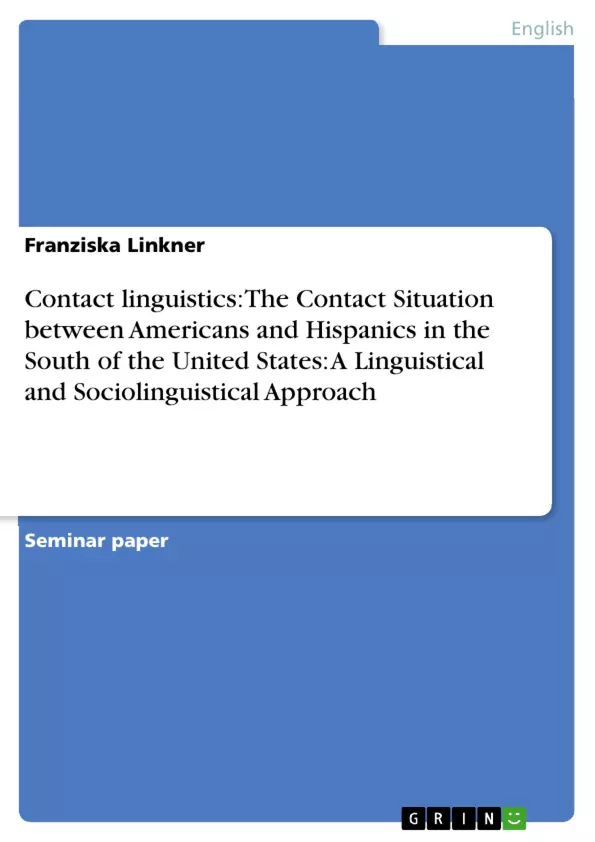As the topic of this terms seminar „ Contact Linguistics and Mixed-Language Genesis: the Case of English” was, I soon thought about the idea to write this term paper about Spanish speaking people living in the south of the United States of America. As a student of both languages, it is interesting for me to see how the so- called Hispanics and Americans live together on American territory and in which way both world languages influence each other. Is there also an influence of Spanish on English, or is it just the other way around?
I would like to have a closer look on the term “Spanglish”, what it means and as what it could be described in linguistical terms. Is it already an independent language or could it become one?
As a starting point it might be interesting to give an overview of the historical and contemporary situation of Hispanics in the USA.
Proceeding from that introduction, I will come to the linguistical aspects. First, I will give a few explanation of terms that might be interesting in the case of Spanish speaking people living in the USA. On that foundation I will attempt not just to have a look on the term Spanglish, but with the help of an example also try to define what kind of linguistical phenomenon it might be.
Finally, I will try to examine the sociocultural circumstances that can be found in those areas like New Mexico, Texas, California, Colorado or Arizona.
A conclusion shall summarize the results of my work and I will try to express my view on the entire situation of Hispanics in the USA.
Inhaltsverzeichnis (Table of Contents)
- Introduction
- Hispanics in the USA
- Historical background
- Contemporary situation
- Linguistical approach
- Terms of interest
- Language contact
- Borrowing
- Bilingualism
- Diglossia
- Code-switching
- General definition
- Prototypical code-switching
- Code-switching by majority speakers
- Motivation of code-switching
- General definition
- English-Spanish language contact in the south of the U.S.
- Linguistical aspects of Spanglish
- Analysis of a Spanglish version of Cervantes' Don Quixote
- An attempt to define the term Spanglish
- Terms of interest
- Socio-cultural approach
- Concerns
- The role of media
Zielsetzung und Themenschwerpunkte (Objectives and Key Themes)
This term paper examines the linguistic and sociolinguistic interaction between American and Hispanic populations in the southern United States. The main objective is to investigate the influence of Spanish on English, and vice-versa, with a particular focus on the phenomenon of Spanglish. The paper explores whether Spanglish constitutes a separate language or a linguistic phenomenon.
- The historical and contemporary situation of Hispanics in the USA.
- Key linguistic concepts relevant to language contact, such as code-switching and borrowing.
- Analysis of Spanglish as a linguistic phenomenon.
- Sociocultural factors influencing language contact in the southern US.
- The role of media in shaping language use and attitudes.
Zusammenfassung der Kapitel (Chapter Summaries)
The introduction outlines the paper's scope and methodology. Chapter 1 provides a historical overview of the Hispanic population in the USA, tracing their arrival from the 1530s to the contemporary situation, including discussions of immigration patterns from Mexico, Puerto Rico, and Cuba. It also explores the complexities of terminology surrounding the Hispanic community in the U.S. Chapter 2 delves into the linguistic aspects of language contact, defining key terms such as code-switching, borrowing, and bilingualism. A significant portion focuses on Spanglish, examining its linguistic features and attempting a definition of the term. Chapter 3 explores the sociocultural context of this linguistic interaction, considering prevalent concerns and the influence of media.
Schlüsselwörter (Keywords)
Keywords: Hispanics in the USA, Language Contact, Spanglish, Code-switching, Bilingualism, Sociolinguistics, American English, Spanish, Immigration, Language Evolution.
- Quote paper
- Franziska Linkner (Author), 2008, Contact linguistics: The Contact Situation between Americans and Hispanics in the South of the United States: A Linguistical and Sociolinguistical Approach, Munich, GRIN Verlag, https://www.grin.com/document/120782



